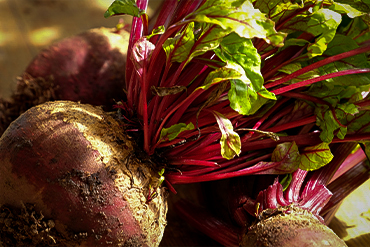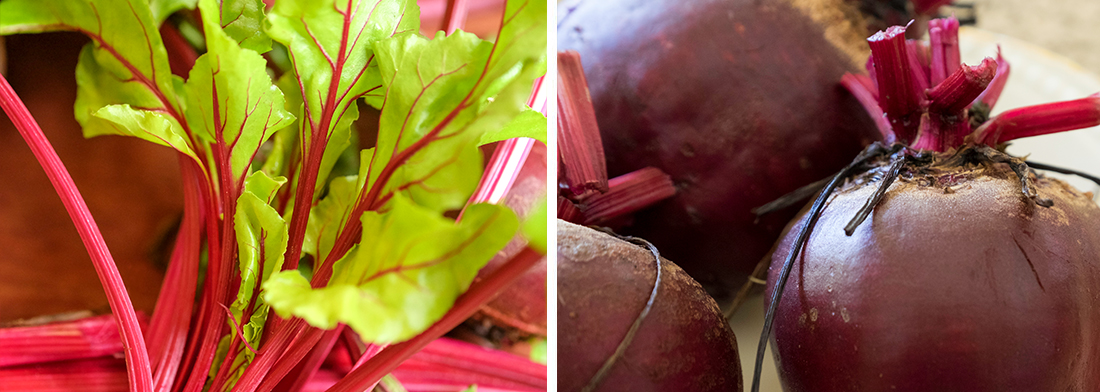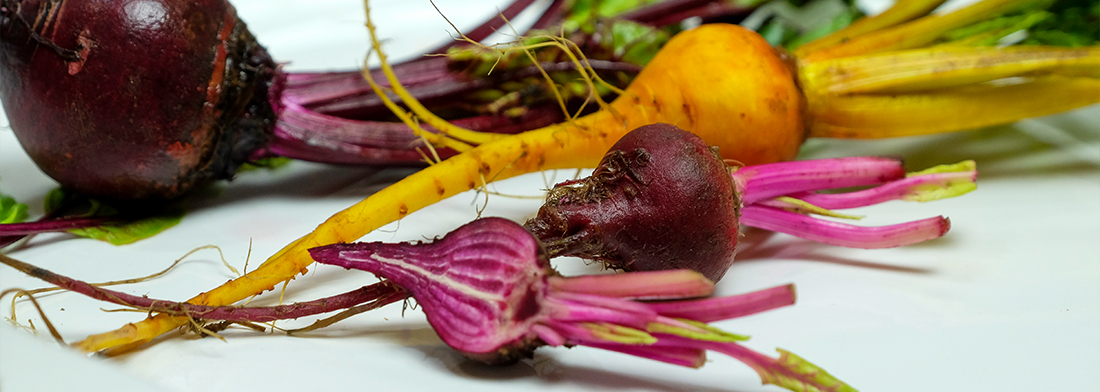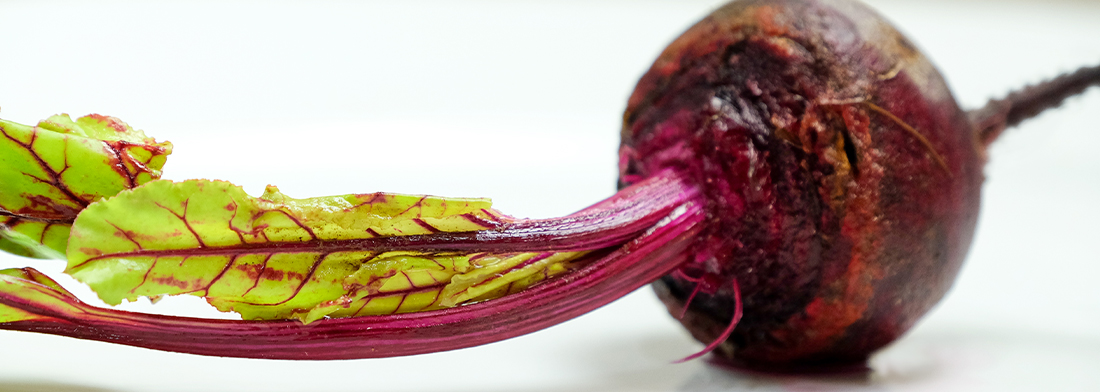
Keeping up with the Beet
- Roots
Following our English culinary ancestry, beetroot remained relatively neglected until it took a turn in the 1960’s. Tinned food and electric can-openers, the modern woman’s kitchen necessities, ushered in the ceremonial crowning of summer’s monotonous iceberg lettuce salad with a slice of beetroot. Later, our burger hallmark, that “bloody” layer of sliced tinned beetroot was sandwiched between the fried egg, onion and the tomato. Two bites in and the river of dragon’s blood, meat juice and egg yolk ooze triggered joyous proclamations of Aussie burger bliss.
 The tides of change have born a groundswell; elevating the old to the new, a renewed appreciation of authentic and endangered flavours and a hankering to shake-off the confines of tradition to explore with unrestrained curiosity. Beetroot, swept up in this invigorating current, is central to our culinary awakening and investigations into eternal youth and enhanced performance. Once only acknowledged as a lowly swollen root, its botanical and culinary diversity is now celebrated through the colourful spectrum of heirloom varieties.
The tides of change have born a groundswell; elevating the old to the new, a renewed appreciation of authentic and endangered flavours and a hankering to shake-off the confines of tradition to explore with unrestrained curiosity. Beetroot, swept up in this invigorating current, is central to our culinary awakening and investigations into eternal youth and enhanced performance. Once only acknowledged as a lowly swollen root, its botanical and culinary diversity is now celebrated through the colourful spectrum of heirloom varieties.
The Dutch Albino, a crisp white root with a sweet mild flavour. Burpee’s Golden, dull orange on the outside but when cut its intense golden yellow is unleashed. It’s not the expected saffron orange hue, akin to Buddhist monks robe, instead it has the luminescence of a flowering canola field. Chioggia, the captivating Venetian, its slightly flattened shape and concentric rings of shocking pink and white are arranged into a perfect bull’s eye. There’s Cylindra, shaped more like a carrot than a beet. Detroit Red and Derwent Globe are the dragon’s blood while Ruby Queen brings a scarlatine rubesence to the Beta vulgaris rainbow. Empowered by the influx of cooking shows, magazine how-to cook segments and the proliferation of smart phone and YouTube video's, beetroot-inspired recipes from every cuisine taunt the curious. Warm salads combine freshly roasted beets with goat, feta or gorgonzola cheese and toasted walnut, hazelnut, or pepitas. It’s teamed with the ancient grains, freekeh and quinoa, or with barley, teff, buckwheat and lentils. It’s blitzed to make beetroot tzatziki and puddled with warm stock and rice and lovingly nurtured to a luscious exotic pink risotto. It’s grated along with crisp juicy apples and celery then tossed with massaged kale and its own baby leaves for a beet slaw.
Empowered by the influx of cooking shows, magazine how-to cook segments and the proliferation of smart phone and YouTube video's, beetroot-inspired recipes from every cuisine taunt the curious. Warm salads combine freshly roasted beets with goat, feta or gorgonzola cheese and toasted walnut, hazelnut, or pepitas. It’s teamed with the ancient grains, freekeh and quinoa, or with barley, teff, buckwheat and lentils. It’s blitzed to make beetroot tzatziki and puddled with warm stock and rice and lovingly nurtured to a luscious exotic pink risotto. It’s grated along with crisp juicy apples and celery then tossed with massaged kale and its own baby leaves for a beet slaw.
 It gives the CWA classic - scones, jam and cream - a respectful nudge as a sweet potato scone and beetroot jam incarnation. It sits comfortably as a roast vegetable in its own right with our traditional pork, beef, lamb and chicken roasts. It can be turned into a delicate chilled soup to give respite to the searing summer heat or made into a simple peasant beef, chicken or even fish-based borsch. A famine food no more, its bold flavour and attitude also marries well with other forthright flavours and delicacies. Horseradish, herrings, anchovy, smoked eels, the fennel family, mustard, soused roll mops, gravlax, smoky meats and charcuterie compliment the beets earthiness, creating enduring pleasures of the table.
It gives the CWA classic - scones, jam and cream - a respectful nudge as a sweet potato scone and beetroot jam incarnation. It sits comfortably as a roast vegetable in its own right with our traditional pork, beef, lamb and chicken roasts. It can be turned into a delicate chilled soup to give respite to the searing summer heat or made into a simple peasant beef, chicken or even fish-based borsch. A famine food no more, its bold flavour and attitude also marries well with other forthright flavours and delicacies. Horseradish, herrings, anchovy, smoked eels, the fennel family, mustard, soused roll mops, gravlax, smoky meats and charcuterie compliment the beets earthiness, creating enduring pleasures of the table.
 Fresh juice hubs peddle its power-food status with liquefied detox carrot, apple, celery and spinach combo’s. It takes intestinal fortitude, repetition and commitment to down this kind of power-juice to build stamina and performance. And, it’s even crossed over into the sweets section where chocolate and beetroot cake and beetroot jelly cheesecake have become a standard in foodie cafés that serve beetroot and turmeric latte’s.
Fresh juice hubs peddle its power-food status with liquefied detox carrot, apple, celery and spinach combo’s. It takes intestinal fortitude, repetition and commitment to down this kind of power-juice to build stamina and performance. And, it’s even crossed over into the sweets section where chocolate and beetroot cake and beetroot jelly cheesecake have become a standard in foodie cafés that serve beetroot and turmeric latte’s.
No longer seen as a defiant child, beetroot carries a new confidence born from acceptance and use. Clothing stains, no longer a social cringe, are the honour badge of wellness. Discard your memories of the beets of yesterday. Embrace the new beets and explore the difference between the pleasure of eating and the pleasures of the table.

